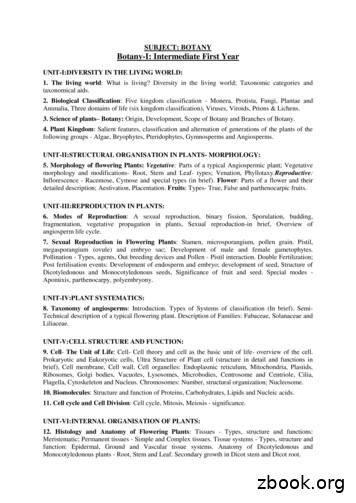8.3 Cell Transport
Lesson Overview8.3 Cell Transport
Lesson OverviewCell TransportPassive TransportThe movement of materials across the cell membrane without usingcellular energy is called passive transport.
Lesson OverviewCell TransportDiffusionThe process by which particles move from an area of high concentration toan area of lower concentration is known as diffusion.- form of passive transport- particles move down the concentration gradient
Lesson OverviewCell TransportDiffusionHigh Conc.Low Conc.
Lesson OverviewDiffusionCell Transport
Lesson OverviewDiffusionCell Transport
Lesson OverviewCell TransportFacilitated DiffusionSome molecules that cannot directly diffuse across the membrane passthrough special protein channels in a process known as facilitateddiffusion.- protein channels are molecule specific- form of passive transport- particles move down concentration gradient
Lesson OverviewCell TransportOsmosis: An Example of FacilitatedDiffusionOsmosis is the diffusion of water through a selectively permeablemembrane.- water moves down concentration gradient- passive
Lesson OverviewCell TransportOsmosis: An Example of FacilitatedDiffusionHypertonic - higher concentration of solute; low concentration of solvent(water)Hypotonic - lower concentration of solute; high concentration of solvent(water)Isotonic - equal concentrations of solute
Lesson OverviewCell TransportHow Osmosis WorksHypotonicHypertonic
Lesson OverviewCell TransportHow Osmosis Works
Lesson OverviewCell TransportOsmotic PressureThe net movement of water in or out of a cell exerts a force known asosmotic pressure.
Lesson OverviewCell TransportOsmotic PressureBecause the cell is filled with salts, sugars, proteins, and other molecules, itis almost always hypertonic to fresh water. So if a cell is in fresh water, watertends to move quickly into the cell, causing it to swell or even burst.
Lesson OverviewCell TransportOsmotic PressureIn plants, the movement of water into the cell causes the central vacuole toswell, pushing cell contents out against the cell wall.
Lesson OverviewCell TransportOsmotic PressureCells in an isotonic solution experience no net gain or loss of water.
Lesson OverviewCell TransportOsmotic PressureIn a hypertonic solution, water rushes out of the cell, causing animal cells toshrink and plant cell vacuoles to collapse.
Lesson OverviewCell TransportActive TransportThe movement of materials against or up a concentration difference isknown as active transport.- requires energy (ATP).
Lesson OverviewCell TransportActive Transportactive transport of smallmolecules or ions happens viatransport proteins, or protein“pumps,” in the membrane.calcium, potassium, and sodiumions use this transport.- example: sodium potassiumpumpprotein shape changes areimportant in the process.
Lesson OverviewCell TransportActive Transport: Bulk TransportBulk Transport moves larger molecules and clumps of material across cellmembranes.- requires energy (ATP)- forms:1. endocytosisa. pinocytosisb. phagocytosis2. exocytosis
Lesson OverviewCell TransportEndocytosisprocess of taking material into the cell by vesicles or vacuoles
Lesson OverviewCell TransportEndocytosisTypes of endocytosis:1. phagocytosis - cytoplasm extensions surround a particle and package itwithin a food vacuole. The cell then engulfs it.Amoebas eat this way.means “cell eating”2. pinocytosis - cells form tiny pockets along the cell membrane.The pockets fill with liquid and pinch off to form vacuoles within the cell.means “cell drinking”
Lesson OverviewCell TransportExocytosismembrane of a vacuole fuses with the cell membrane, forcing the vacuolecontents out of the cell.
Lesson Overview Cell Transport Passive Transport. . Active Transport. The movement of materials . against or up . a concentration difference is known as . active transport. . Bulk Transport moves larger mo
Types of Transport There are 3 types of transport in cells: 1. Passive Transport: does not use the cell’s energy in bringing materials in & out of the cell 2. Active Transport: does use the cell’s energy in bringing materials in & out of the cell 3. Bulk Transport: involves the cell making me
of the cell and eventually divides into two daughter cells is termed cell cycle. Cell cycle includes three processes cell division, DNA replication and cell growth in coordinated way. Duration of cell cycle can vary from organism to organism and also from cell type to cell type. (e.g., in Yeast cell cycle is of 90 minutes, in human 24 hrs.)
UNIT-V:CELL STRUCTURE AND FUNCTION: 9. Cell- The Unit of Life: Cell- Cell theory and cell as the basic unit of life- overview of the cell. Prokaryotic and Eukoryotic cells, Ultra Structure of Plant cell (structure in detail and functions in brief), Cell membrane, Cell wall, Cell organelles: Endoplasmic reticulum, Mitochondria, Plastids,
Cell Transport : 19. word that means "cell" Name:_ Cell Transport Packet For questions 1-10, use Figure 1. Match the structure/process to the letter: 1. Phospholipid bilayer _ : 6. type of transport that does not require energy 8. solution the cell is placed in) .
Transport Management System of Nepal Nepalese transport management is affected by existing topographical condition of the country. Due to this only means of transport used in the country are road transport and air transport. In this paper only road transport is discussed. During the Tenth Plan period, the vehicle transport management
Jan 21, 2020 · pertaining to the cell theory, structure and functions, cell types and modifications, cell cycle and transport mechanisms. This module has seven (7) lessons: Lesson 1- Cell Theory Lesson 2- Cell Structure and Functions Lesson 3- Prokaryotic vs Eukaryotic Cells Lesson 4- Cell Types and Cell
The Cell Cycle The cell cycle is the series of events in the growth and division of a cell. In the prokaryotic cell cycle, the cell grows, duplicates its DNA, and divides by pinching in the cell membrane. The eukaryotic cell cycle has four stages (the first three of which are referred to as interphase): In the G 1 phase, the cell grows.
BEC HIGHER PART TWO Questions 13 – 22 You will hear five different business people talking about trips they have recently been on. For each extract there are two tasks. For Task One, choose the purpose of each trip from the list A – H.F or Task Two, choose the problem described from the list A – H . Y ou will hear the recording twice. T ASK ONE – PURPOSE For questions 13 .























